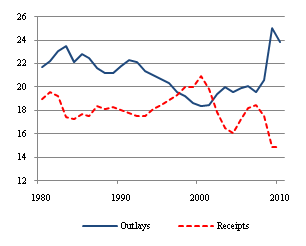Immigration Policy in the United States: An Update
December 3rd, 2010 by Douglas ElmendorfToday CBO released an update to its February 2006 paper Immigration Policy in the United States. The publication is a collection of tables and figures with descriptive text (shown below). The update presents data through 2009 and makes comparisons with 2004, the most recent year for which most data were reported in the earlier paper. The first and largest group of exhibits—exhibits 1 through 13—provides statistics on admissions of foreign nationals as legal permanent residents of the United States. The second group—exhibits 14 through 18—presents data on temporary residents and visitors. The third set—exhibits 19 and 20—provides information on naturalization of residents, and the final set—exhibits 21 and 22—shows data on enforcement of immigration laws.
A national of a foreign country granted permanent admission to the United States is formally classified as a legal permanent resident (LPR) and receives a document, commonly known as a green card. (Generally, such foreign nationals must initially obtain a visa to enter the country.) In 2009, the United States granted legal permanent resident status to more than 1.1 million people. About two-thirds of those people were admitted to the United States on the basis of family connections to current U.S. citizens or residents. LPRs are eligible to live and work in the United States, and eventually, they may apply to become naturalized citizens. Today’s report notes that:
- Of the 1.1 million people granted LPR status in 2009, about 463,000 (or 41 percent) were first-time entrants to the United States, and about 668,000 (or 59 percent) were already inside the United States when they were granted LPR status.
- The total number of permanent admissions was about the average for the previous four years but 18 percent more than were granted such status in 2004.
- In 2009, foreign nationals who were born in Asia accounted for 37 percent of the people granted LPR status, and people who were born in North America (including Central America) accounted for 33 percent.
- The number of individuals admitted on the basis of employment preferences decreased slightly between 2004 and 2009 and accounted for 13 percent of admissions. The category of people admitted for humanitarian reasons, which constituted 17 percent of the permanent admissions in 2009, grew by almost 60 percent from its level five years earlier.
Visas for temporary admission to the United States are granted to foreign nationals who seek entry for a limited time and for a specific purpose, such as tourism, diplomacy, or study. In addition, foreign nationals who meet certain criteria may be permitted to work in the United States for a limited time that depends on the type of visa they receive. Foreign nationals with temporary visas are not eligible for citizenship, and to remain in the United States on a permanent basis they would be required to apply for permanent admission. CBO’s publication reports that:
- About 5.8 million visas for temporary admission were issued in 2009, of which 24 percent were for temporary residents and 76 percent were for visitors.
- Although the number of visas issued was 15 percent higher than the number in 2004, it was down by almost 800,000 (or 12 percent) from the 6.6 million visas issued in 2008. The decrease was most likely a result of the global recession: Fewer visas were issued for business, for tourism, and for employment.
- The number of legal temporary admissions is much greater than the number of visas because many people do not need visas or had multiple admissions. In 2009, there were about 163 million legal temporary admissions, the lowest number since the Department of Homeland Security began reporting those data in 2003. About 135 million of those admissions were people from North America (including Central America).
Legal permanent residents may become citizens of the United States through a process known as naturalization. To become a naturalized citizen, an applicant must fulfill certain requirements set forth in the Immigration and Nationality Act. The report shows:
- About 744,000 people became naturalized U.S. citizens last year, which is well below the number naturalized in 2008 but close to the average for the past five years. Of the 2009 total, the largest percentages of people were born in Mexico (15 percent) and India (7 percent).
The Department of Homeland Security (DHS) is responsible for enforcing immigration law and arrests, detains, returns, and removes foreign nationals who violate U.S. laws. CBO’s report indicates that:
- In 2009, about 580,000 people who were arrested or detained returned voluntarily under the supervision of a DHS official to their home country or to another country, a figure that is well below the number in recent years.
- About 393,000 people were ordered removed in 2009, which is 63 percent more than were ordered removed in 2004. In 2009, about two-thirds of total removals were for noncriminal violations, such as a lack of proper documentation, and the other one-third were for criminal violations of U.S. laws.
The updated study is one of a series of updates of earlier CBO immigration studies. All of CBO’s immigration publications can be found here. This update was prepared by Paige Piper/Bach and Brian Prest of CBO’s Microeconomic Studies Division.

